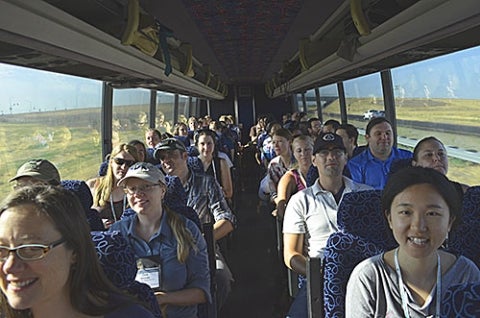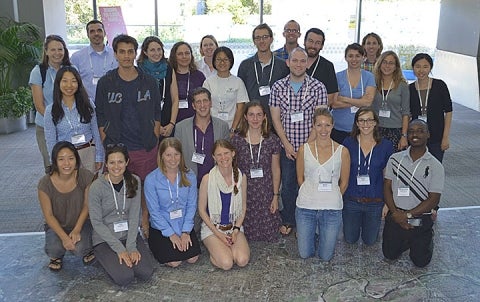Note: Yale School of the Environment (YSE) was formerly known as the Yale School of Forestry & Environmental Studies (F&ES). News articles and events posted prior to July 1, 2020 refer to the School's name at that time.
 <p class="p1"> ESI Fellows and project managers use a 20-foot-by-30-foot map to explore existing issues and opportunities the American RIver Parkway.</p>
<p class="p1"> ESI Fellows and project managers use a 20-foot-by-30-foot map to explore existing issues and opportunities the American RIver Parkway.</p>
Alexander Felson has long touted the importance of including ecologists in the process of urban design. A couple of years ago he had an idea of how to directly engage those ecologists: take over their annual meeting.
In August, he did just that… Well, sort of.
At the invitation of the Ecological Society of America (ESA), Felson — an assistant professor at the Yale School of Forestry & Environmental Studies and the Yale School of Architecture — and a Yale-led group of fellows descended on the scientific organization’s annual conference in Sacramento, Calif. Following a year of planning, the group created a series of interactive installations throughout the Sacramento Convention Center, and organized workshops and field events to illustrate how ecology can be used to help solve larger societal challenges.
Across the third floor of the center, they unfurled a 30-foot-by-20-foot map of the American River Parkway (ARP) — an open space greenbelt that runs through the heart of Sacramento — that became a centerpiece of their educational program, inspiring discussions among stakeholders and passersby alike.
In August, he did just that… Well, sort of.
At the invitation of the Ecological Society of America (ESA), Felson — an assistant professor at the Yale School of Forestry & Environmental Studies and the Yale School of Architecture — and a Yale-led group of fellows descended on the scientific organization’s annual conference in Sacramento, Calif. Following a year of planning, the group created a series of interactive installations throughout the Sacramento Convention Center, and organized workshops and field events to illustrate how ecology can be used to help solve larger societal challenges.
Across the third floor of the center, they unfurled a 30-foot-by-20-foot map of the American River Parkway (ARP) — an open space greenbelt that runs through the heart of Sacramento — that became a centerpiece of their educational program, inspiring discussions among stakeholders and passersby alike.
It felt a little like kindergarten, which was great because it got everyone’s creative juices flowing.
They organized their own panel discussions and field trips. And they set up a series of demonstrations that encouraged visitors to contemplate and explore the promise of green infrastructure — from window decals that allowed people to design their own projects with stickers and markers to plant-filled kiddie pools designed to attract pollinating bees.
“It felt a little like kindergarten, which was great because it got everyone’s creative juices flowing,” said Rushyan Yen ’15 M.E.M. M.Arch., who coordinated the event as program manager. “The vision was to get the ESA members to think beyond their research and science and to think in terms of how to apply it…. And because we were in the middle of the conference, people would stumble across our space and become part of the conversation.”
“It really stimulated a lot of unexpected interactions between top ecologists and top designers.”
The project, called the Earth Stewardship Initiative, was coordinated by Felson, Jill S. Baron of the U.S. Geological Survey and Colorado State University, and Neal Williams, an associate professor at the University of California-Davis.
Together, they recruited a team of 15 fellows and 20 research students from universities across the country — including five from Yale — to design the installations and participate in a weeklong ecology-driven, land-planning project.
“It felt a little like kindergarten, which was great because it got everyone’s creative juices flowing,” said Rushyan Yen ’15 M.E.M. M.Arch., who coordinated the event as program manager. “The vision was to get the ESA members to think beyond their research and science and to think in terms of how to apply it…. And because we were in the middle of the conference, people would stumble across our space and become part of the conversation.”
“It really stimulated a lot of unexpected interactions between top ecologists and top designers.”
The project, called the Earth Stewardship Initiative, was coordinated by Felson, Jill S. Baron of the U.S. Geological Survey and Colorado State University, and Neal Williams, an associate professor at the University of California-Davis.
Together, they recruited a team of 15 fellows and 20 research students from universities across the country — including five from Yale — to design the installations and participate in a weeklong ecology-driven, land-planning project.
 <p class="p1"> ESI Fellows and ESA members embark on a site visit to the American River Parkway, which became the most well attended field trip during the week-long ESA conference.</p>
<p class="p1"> ESI Fellows and ESA members embark on a site visit to the American River Parkway, which became the most well attended field trip during the week-long ESA conference.</p>
Working with leaders from the ESA and the American River Parkway, the students helped lead an informational “bioblitz” session and field trip to sites along the parkway. They helped coordinate a design charette that used the Sacramento river project as a case study in how ecologists can incorporate sustainable principles into urban planning and landscape architecture.
And each day they filled the halls of the conference center, meeting at the ecological art installations to explore ways that ecological science and research can encourage more collaborative thinking in the design and construction of green infrastructure.
Inspiring such interaction was critical for Felson, who has long encouraged ecologists to play a more active role in urban design through so-called “designed experiments” — or projects that incorporate ecological research into traditional design and construction.
“The success of this project relied on the level of engagement by the students and the stakeholders,” Felson said. “And they showed up in force, participating throughout the week.”
And each day they filled the halls of the conference center, meeting at the ecological art installations to explore ways that ecological science and research can encourage more collaborative thinking in the design and construction of green infrastructure.
Inspiring such interaction was critical for Felson, who has long encouraged ecologists to play a more active role in urban design through so-called “designed experiments” — or projects that incorporate ecological research into traditional design and construction.
“The success of this project relied on the level of engagement by the students and the stakeholders,” Felson said. “And they showed up in force, participating throughout the week.”
The success of this project relied on the level of engagement by the students and the stakeholders. And they showed up in force.
The benefits of the event, Felson says, were multifold. For the students, it was an opportunity to see how ecologists can transform the dialogue around a local green infrastructure system — and how urban ecology can really work. (Those lessons will continue this semester when the students in Felson’s Ecological Urban Design class will explore lessons from the Sacramento project — and the recent ESA conference.)
The project, he says, created a new forum that allowed stakeholders involved in the American Rivers Parkway project to come together in ways that they never have before, inspiring an unprecedented level of communication that have continued after the conference.
And for members of the ESA, it introduced a new model for exploring land planning and community-based projects.
“It served as a real educational opportunity for us and was a real forum for those stakeholders to have their discussions,” Felson said. “But it also helped ESA members see how they can expand the impact they have on society moving forward. They’ve already voted to do it again at their annual meeting next year in Baltimore.”
Other participants in the project included AECOM, an engineering and design firm; the Sacramento Area Flood Control Agency; the Sacramento County Regional Parks Water Forum; the American River Parkway Foundation; the U.S. Bureau of Reclamation; the U.S. Fish and Wildlife Service; CBEC Eco-Engineering; and Cramer Fish Sciences.
The project, he says, created a new forum that allowed stakeholders involved in the American Rivers Parkway project to come together in ways that they never have before, inspiring an unprecedented level of communication that have continued after the conference.
And for members of the ESA, it introduced a new model for exploring land planning and community-based projects.
“It served as a real educational opportunity for us and was a real forum for those stakeholders to have their discussions,” Felson said. “But it also helped ESA members see how they can expand the impact they have on society moving forward. They’ve already voted to do it again at their annual meeting next year in Baltimore.”
Other participants in the project included AECOM, an engineering and design firm; the Sacramento Area Flood Control Agency; the Sacramento County Regional Parks Water Forum; the American River Parkway Foundation; the U.S. Bureau of Reclamation; the U.S. Fish and Wildlife Service; CBEC Eco-Engineering; and Cramer Fish Sciences.
 <p class="p1"> Alexander Felson (center), with the doctoral, post doctoral and graduate students selected to be Earth Stewardship Initiative Fellows, including Rushyan Yen ’15 M.E.M./M.Arch (front, far left); Julia Anderson ’16 M.E.M./M.P.H. (front, second from left); Sarah Sugar ’15 M.E.M. (front, second from right); Acheampong Atta-Boateng ’14 M.F.S. (front, far right); and Ross Bernet ’15 M.E.M. (back, ninth from left).</p>
<p class="p1"> Alexander Felson (center), with the doctoral, post doctoral and graduate students selected to be Earth Stewardship Initiative Fellows, including Rushyan Yen ’15 M.E.M./M.Arch (front, far left); Julia Anderson ’16 M.E.M./M.P.H. (front, second from left); Sarah Sugar ’15 M.E.M. (front, second from right); Acheampong Atta-Boateng ’14 M.F.S. (front, far right); and Ross Bernet ’15 M.E.M. (back, ninth from left).</p>
– Kevin Dennehy kevin.dennehy@yale.edu 203 436-4842
Published
September 10, 2014